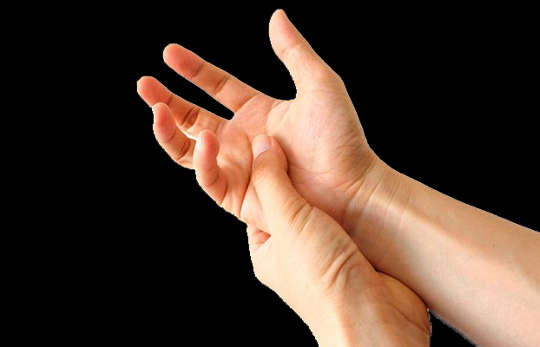
Though the Art of Jin Shin bears some similarities to acupuncture, the practice achieves its transformative results without needles, using only a gentle touch—a methodology that translates very nicely to self-care. All you need in order to get started are your fingers and hands, and a little bit of time and patience.
The holds and flows will grow more effective as you become an ever more adept reader of your body’s signals. However and whenever you start, to some degree you will succeed in moving stagnant energy and restoring harmony right from the get-go—and that’s part of the beauty of Jin Shin.
Each of us is endowed with the innate ability to balance and heal our physical, mental, and spiritual selves. Jin Shin allows us to tap into the body’s innate physical and spiritual wisdom, lifting us out of the jagged rhythms of modern life and returning our bodies to the rhythm of the universal clock. We always have the necessary tools to practice—our breath, fingers, and hands—and there’s no way to harm ourselves using the holds and flows.
THE CORE CONCEPTS OF THE ART OF JIN SHIN
You don’t need deep technical knowledge of the intricate pathways Jiro Murai identified in order to apply the holds and flows of Jin Shin. However, cultivating an internal awareness of the connections in your body will only help your practice, as will a basic understanding of the concepts that animate Jin Shin.
Get The Latest By Email
To that end, here’s a brief and simple primer on the foundations of the practice.
Energy
A construct that is accepted in Japanese culture yet still requires explanation in the West, the idea of source energy—ki-eki, also known as universal or ancestral energy—is key to our work. This source energy animates every molecule in the universe, from the stars in the sky to the bone in your littlest toe, and this energy is what we tap into when we perform Jin Shin.
Source energy moves through various pathways in our bodies in a continuous pattern (down the front of the body and up the back), feeding life into all of our cells. When the pattern is disrupted—by stress, trauma, exposure, or other events—blockages result. This damming effect leads to discomfort, pain, or illness, and by relieving the damming and restoring the flow of energy, Jin Shin brings relief.
A note: There are actually two kinds of energy within Jin Shin, ki-eki, as described above, and tai-eki, which refers to individual energy. For the purposes of this book we will not be making a distinction between them, though we’ll learn a bit more about tai-eki in chapters to come.
Breath
The practice of conscious “abdominal” breathing, familiar to anyone who has meditated or practiced yoga, is the most basic (and arguably most important) form of Jin Shin self-care. It’s also the bridge between the conscious and unconscious functions of our nervous system.
When we take “diaphragmatic” or “abdominal” breaths, allowing the abdomen to expand on the inhalation so that the diaphragm can make more room for the lungs to expand fully, receptors inside the lungs send electrical and chemical signals to the brain. These signals turn on the parasympathetic nervous system that allows our bodies to rest, digest, heal, and repair—telling our brains to do things like lower our blood pressure and slow down our heartbeats. Isolated within the chest, the short, shallow breaths we take as a response to stress keep our bodies in a constant state of fight-or-flight. This agitated state of sympathetic stimulation makes it very hard for healing to occur.
A tool so powerful it’s been shown to help soldiers suffering from PTSD, abdominal breathing is the baseline of many holistic techniques. Within the practice of Jin Shin, breathing begins the process of moving energy through the body and makes clients more receptive to treatment. Clients can actually unlock blockages and spark their pulses merely through the use of their breath, which is why when a Jin Shin practitioner can’t feel a pulse, asking a client to breathe will often cause the energy to begin to move.
Aim to consciously practice abdominal breathing as you begin to explore the flows and holds outlined in this book.
The Use of the Hands
Whether we are using self-care or placing our bodies in the care of a Jin Shin practitioner, the only tools needed for this practice are a pair of hands. The hands are seen as jumper cables, resetting the flow of energy in the body.
For the practitioner, the hands also receive vital information about the client’s pulses (see below), hot or cold areas of the body, muscular tightness, or textural inconsistencies. A note: When you’re being treated by a practitioner, he or she will use the eyes as well—looking for swellings, postural misalignment, skin disorders, poor blood circulation, and other signs of energetic imbalance.
Pulse
As you practice the holds and flows [of Jin Shin], over time you’ll begin to develop a sensitivity to your energetic pulse, one of the primary sources of feedback in Jin Shin. Distinct from the arterial pulses which measure the flow of blood to and from the heart, Jin Shin’s energetic pulses are the result of vital source energy spiraling to the bone or the core of the body and back in response to the practitioner’s touch.
The advantage to feeling a pulse quickening or slowing as the treatment takes hold is one of several reasons Jin Shin practitioners use their hands instead of needles (as in acupuncture) or other implements. The pulses give us information about which areas of the body need to be harmonized.
Symmetry
It may not seem logical to treat a lung, heart, or digestive issue by holding your inner knee. To Jin Shin practitioners the relationship is clear, because the vertical movement of energy through the body creates a mirror relationship between the upper and lower body. To resolve issues in the upper half of the body, a Jin Shin practitioner will often choose an area on the lower half of the body, creating an escape route so the stuck energy has a place to go.
Similarly, there is an interplay between the left and right sides of the body. The right side of the body tends to exhibit symptoms related to lifestyle issues, where the left side carries the mark of older traumas or hereditary predispositions.
The Safety Energy Locations (SELs)
We use our hands to harmonize distinct locations on the body—these are the Safety Energy Locations (SELs). The function and location of the SELs was one of Jiro Murai’s most eye-opening discoveries. As his investigations determined, when an energetic flow falls out of balance, energy tends to come to a halt—the body shorting its electrical supply in order to avoid a major electrical surge.
Using the specific locations he discovered, the energy begins flowing through the congested areas again and, like a traffic jam, the congestion resolves. Oftentimes overlapping with acupressure points, these twenty-six locations run about three inches across—about the size of the palm of your hand—and they are mirrored on the right and left sides of the body. The areas can be held singly (a “hold”) or in simultaneous and successive pairings (a “flow”). When all twenty-six SELs on both sides are open and flowing without interruption, there is harmony in the body.
Self-Care
As a Jin Shin practitioner, I encourage all of my clients to practice daily self-care in order to extend the benefits of our sessions and keep the body in energetic alignment. Many continue to practice long after the end of our sessions, on a daily basis or as feels right to them, and they make these routines an integral part of their lives.
Similarly, whatever your reasons for picking up this book, I encourage you to consider the benefits of self-care as a long-term practice. Whether you use Jin Shin’s banquet of self-healing holds and flows as an occasional first-aid tool or a daily maintenance habit, like brushing your teeth, you’ll find a wide world of healing within the pages of this book.
©2019 by Alexis Brink.
All Rights Reserved. Excerpted with permission.
Publisher: Tiller Press, an imprint of Simon & Schuster.
Article Source
The Art of Jin Shin: The Japanese Practice of Healing with Your Fingertips
by Alexis Brink Balance your body, mind, and spirit and heal yourself with your own hands using this clear, step-by-step illustrated guide to the practice of the ancient Japanese healing art of Jin Shin—written by a trained expert with nearly three decades of experience. The Art of Jin Shin explains all the basics of this healing art and provides you with the knowledge you need to practice it on yourself—with exercises ranging from simply holding a finger for a few minutes to spending twenty minutes to harmonize a specific circulation pattern. (Also available as an e-Textbook, an Audiobook, and a Audio CD.)
Balance your body, mind, and spirit and heal yourself with your own hands using this clear, step-by-step illustrated guide to the practice of the ancient Japanese healing art of Jin Shin—written by a trained expert with nearly three decades of experience. The Art of Jin Shin explains all the basics of this healing art and provides you with the knowledge you need to practice it on yourself—with exercises ranging from simply holding a finger for a few minutes to spending twenty minutes to harmonize a specific circulation pattern. (Also available as an e-Textbook, an Audiobook, and a Audio CD.)
For More Info and to Order this book.
About the Author
 Alexis Brink is the president of Jin Shin Institute in New York City and has been a practitioner of the Art of Jin Shin since 1991. She is a Licensed Massage Therapist and interfaith minister and has taught self-help classes and workshops in NYC as well as in different countries for many years. She has taught Jin Shin in hospitals to nurses and to teachers and their students in the public school system. TheJin Shin Institute under Alexis' guidance is offering a comprehensive curriculum to the new generation of practitioners and teachers. Visit JinShinInstitute.com for more information.
Alexis Brink is the president of Jin Shin Institute in New York City and has been a practitioner of the Art of Jin Shin since 1991. She is a Licensed Massage Therapist and interfaith minister and has taught self-help classes and workshops in NYC as well as in different countries for many years. She has taught Jin Shin in hospitals to nurses and to teachers and their students in the public school system. TheJin Shin Institute under Alexis' guidance is offering a comprehensive curriculum to the new generation of practitioners and teachers. Visit JinShinInstitute.com for more information.









